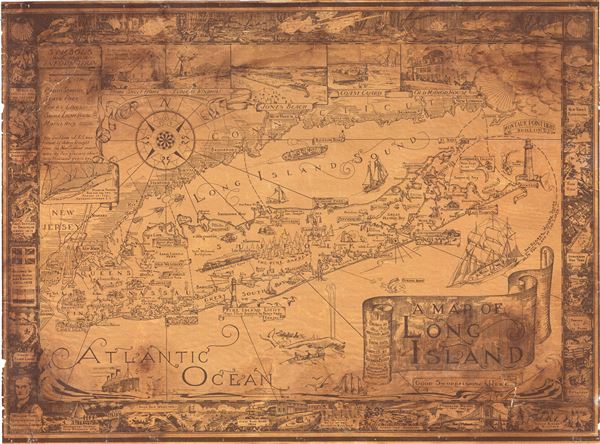
This item below is out of stock, but another example (left) is available. To view the available item, click "Details."
Details
1961 Courtland Smith Pictorial Map of Long Island, New York
$750.00
1961 Courtland Smith Pictorial Map of Long Island, New York
LongIsland-smith-1961
Title
1961 (dated) 23.5 x 31.5 in (59.69 x 80.01 cm) 1 : 337920
Description
The top left quadrant of the map includes the note, 'The backbone of L.I. was formed by debris brought from the New England Mountains by two glaciers about forty thousand years ago' as well as an inset featuring a 'Diagram showing how far the two Stages of Ice Advance covered L.I.' Five beautiful illustrated views along the top border include the Birthplace of John Howard Payne East Hampton, a Typical Windmill, Jones Beach, Coast Guard and Old Manor House. A decorative compass rose and an art deco style wind figure are also featured. In Long Island Sound and the Atlantic Ocean, pictorial illustrations of Boston Boat, ships, striped bass, a swordfish, whale fishing, and the Sag Harbor Whalers that 'sailed to the ends of the Earth' can be seen. The map is surrounded by an elaborate border, with underwater scenes at the top and historic events and places along the remaining three sides, including the '13 Tribes of Indians when First Settlers Arrived,' 'First Settled at Brooklyn in 1614,' 'First Rail Road 1836,' 'Brooklyn Bridge 1867-1883,' etc.
Courtland Smith, an architect by profession, drew this map during the years of the Great Depression as a 'keep-busy project' on the suggestion of his friend Richard Forster, who is credited here for compiling the data for this map. It quickly became extremely popular and according to Courtland Smith's obituary in the Southampton Press, it became the 'steady seller in gift shops throughout Long Island for more than 75 years.' When Smith died, the mayor of Southampton remarked about this map:
That map has had a significant impact on the development of not only Southampton, but all the other towns on Long Island that it features.This map was drawn by Courtland Smith from data compiled by Richard Foster and published by The Billboard Barn, Southampton, L.I. It was printed by Gerson Offset Litho Co., Inc., New York. This map, first printed in 1933 became extremely popular and has since been widely reprinted â€' the present example is the 1961 edition.
Cartographer
Courtland Elmer Smith (December 3, 1907 - March 4, 2005) was an American architect, illustrator, and designer. He was born in Southampton, New York, the son of Elmer Smith, then village mayor. Smith studied at the University of Pennsylvania, attaining a degree in architecture in 1929, just in time for Black Tuesday. Smith worked on and off during Great Depression. In 1933, he worked with friend Richard 'Dick' Foster to compile a pictorial map of Long Island. As the Great Depression eased, Smith got more and more architecture work, becoming known for a clean uncluttered style. His work took him all over the world, and includes Houston Astrodome, the Distant Early Warning (DEW Line) radar defense system in the Arctic, and foreign aid projects for the U.S. Agency for International Development. After living abroad for many years, he returned to his native Southampton in 1966. He remained there in his family home until his death in 2005. (The Southampton Press, March 10, 2005) More by this mapmaker...

